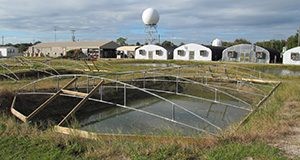Abstract
Aquaculture is an important and diverse segment of the agricultural economy in Florida. Ornamental, live bait, food finfish, and other segments of this industry culture and trade in non-native species. Escape or release of these non-native cultured organisms is an environmental and legal concern in Florida and therefore a key consideration in aquaculture farm construction and operation. This 7-page fact sheet is the first in a four-part series devoted to educating industry and other stakeholders on the importance of preventing the escape of non-native species from aquaculture facilities, as well as strategies for non-native species containment and regulatory compliance. It introduces the series, explains why non-native species containment is important, provides information on regulations, including the Florida Aquaculture Best Management Practices rule, describes the BMP inspection process, and provides advice on achieving compliance with these important regulations. Written by Quenton M. Tuckett, Carlos V. Martinez, Jared L. Ritch, Katelyn M. Lawson, and Jeffrey E. Hill, and published by the School of Forest Resources and Conservation Program in Fisheries and Aquatic Sciences, August 2016.
References
FDACS. 2015. Aquaculture Best Management Practices Rule. Florida Department of Agriculture and Consumer Services, Division of Aquaculture, Tallahassee, FL.
Florida Statutes. 2013. Florida Statutes 597.001 - 597.020.
Hill, J. E. 2008. Non-Native Species in Aquaculture : Terminology, Potential Impacts, and the Invasion Process. Southern Regional Aquaculture Center. Southern Regional Aquaculture Center, Stoneville MS, Publication No. 4303.
Hill, J. E. 2009. Risk Analysis for Non-Native Species in Aquaculture. Southern Regional Aquaculture Center, Stoneville MS, Publication No. 4304.
Hill, J. E. 2011. Emerging Issues Regarding Non-Native Species for Aquaculture. Southern Regional Aquaculture Center, Stoneville MS, Publication No. 4305.
Hill, J. E. 2013. Regulations Pertaining to Non-native Fish in Florida Florida Fish and Wildlife Florida Department of Agriculture. FA-121. Gainesville: University of Florida Institute of Food and Agricultural Sciences. http://edis.ifas.ufl.edu/fa121
Hill, J. E., Q. M. Tuckett, C. V. Martinez, J. L. Ritch, and K. M. Lawson. 2016. Preventing escape of non-native species from aquaculture facilities in Florida, part 2: facility evaluation strategies. FA-196. Gainesville: University of Florida Institute of Food and Agricultural Sciences. http://edis.ifas.ufl.edu/fa196
Hill, J. E., and R. P. E. Yanong. 2010. Freshwater ornamental fish commonly cultured in Florida. CIR-54. Gainesville: University of Florida Institute of Food and Agricultural Sciences. http://edis.ifas.ufl.edu/fa054
Tuckett, Q. M., C. V. Martinez, J. L. Ritch, K. M. Lawson, and J. E. Hill. 2016a. Preventing escape of non-native species from aquaculture facilities in Florida, part 3: structural strategies. FA197. Gainesville: University of Florida Institute of Food and Agricultural Sciences. http://edis.ifas.ufl.edu/fa197
Tuckett, Q. M., C. V. Martinez, J. L. Ritch, K. M. Lawson, and J. E. Hill. 2016b. Preventing escape of non-native species from aquaculture facilities in Florida, part 4: operational strategies. FA199. Gainesville: University of Florida Institute of Food and Agricultural Sciences. http://edis.ifas.ufl.edu/fa199
Tuckett, Q. M., J. L. Ritch, K. M. Lawson, and J. E. Hill. 2016c. "Implementation and Enforcement of Best Management Practices for Florida Ornamental Aquaculture with an Emphasis on Nonnative Species." North American Journal of Aquaculture 78:113-124. https://doi.org/10.1080/15222055.2015.1121176

